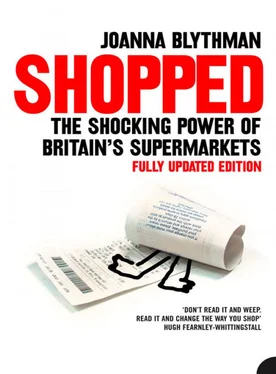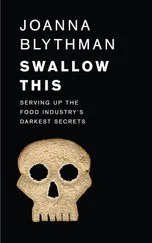Given this regulatory climate, it is not surprising that the big multiples’ efforts to build their portfolio in the ‘small basket’ sector are escalating. As Richard Hyman of the market research company Verdict told The Times , ‘this was always a market that the big boys were going to get into big time’. In October 2002, the Co-op started off the big buying with its acquisition of the grocery chain Alldays. Three days later, it was no surprise to discover that Tesco had got the go-ahead from the Office of Fair Trading (OFT) to buy up the T&S chain of convenience stores, using this two-market yardstick. Tesco gained out of the deal the 450 new Express stores it created from the T&S stores, adding a cool 1 per cent to its market share, without raising a regulatory whimper. The OFT decided that the T&S acquisition gave Tesco only 5 per cent of the convenience market so that was OK. But as one industry analyst told the Daily Telegraph , with the T&S deal, ‘Tesco had done a land grab which would probably have taken them eight years to do piecemeal and probably 15 years in terms of all the planning wrangles there would have been.’ By the end of 2003, Tesco was opening Express stores at a rate of one a week.
There’s no doubt that the Competition Commission’s artificial division of the grocery market has turned out to be highly advantageous for the large supermarket chains. As Bill Grimsey, the chief executive officer of the retail and wholesale Big Food Group, put it: ‘It allows the already dominant multiples to bring their strength back into the high streets and local neighbourhoods, eventually working against the interests of shoppers, suppliers and the livelihoods of the smaller independents … They will also, in the long term, limit consumer choice and potentially lead to higher prices as competition eventually diminishes. Suppliers and consumers will be faced by a world dominated by two or three companies.’ A troubling prospect, isn’t it?
How on earth did Britain get into a situation where independent shops are an endangered species and a handful of powerful retailers are heading for total control of the nation’s food shopping – all in three decades? If consumers had been asked to vote on whether this was a desirable set of affairs, the resounding response would have been no; yet this is precisely what has happened. How did our regulatory system let us down?
When supermarkets started appearing in Britain during the 1960s, it was not instantly obvious that they were the forerunners of retail monsters. They were sufficiently few and far between not to cause undue concern. By today’s standards they were relatively small. Small shopkeepers were fearful about losing business to the new retail giants, but most people welcomed them. For most shoppers, they were something of a novelty, a new retail experience, a welcome addition to traditional shopping outlets – butchers, fishmongers, grocers and so on – adding to the all-round grocery shopping choice. Consumers saw the new supermarkets as an ‘as well as’ not an ‘instead of’ feature of the shopping scene. Local councils often viewed them positively as a whole new pot of rateable revenue.
By the late 1980s, however, supermarkets were multiplying at a steady rate. They were becoming bigger too. The nightmare scenarios articulated by independent shopkeepers were beginning to be played out on the high street. Belatedly, the penny dropped that a supermarket land grab was under way. It became obvious that some restrictions to curb the spread of supermarkets would be needed. In 1988, the Department of the Environment issued a planning policy note (PPG6) for England containing general guidance for local authorities. This said that although the planning system should not inhibit competition between retailers – perish the thought! – it should take into account whether a new supermarket would affect the vitality and viability of a nearby town centre. But this guidance proved totally inadequate to slow down the supermarkets’ inexorable push for retail space. A proliferation of large superstores followed.
The supermarket retail revolution no longer meant the odd useful store on the edge of urban areas, but a ring of similar developments creating a supermarket bracelet around towns and cities, a bracelet elastic enough to allow the insertion of ever more links. Chain B would build a new store, bigger and better than chain A’s existing store in the area. So chain A would respond with another bigger store to claw back the business the newcomer had taken away. Chain C, meanwhile, not to be outdone, would open its store to make sure it got its slice of the retail action.
People were surprised, and even shocked, to find that these superstores were sometimes constructed on greenfield land, even playing fields, which they had always supposed would never be put under hard landscaping of any sort, naively assuming that they would be protected by local development plans. Such plans proved to be weaker and more open to interpretation than many had supposed. Local planners felt their hands were tied. Even if they had the will to say no, they lacked the regulatory ammunition.
By 1993, the decline of small traders as a critical proportion of their customers began to drift off to the shiny new superstores with limitless free parking had become sufficiently acute for the government to issue a revised version of PPG6. This stressed the need for a suitable balance between developments in town centres and out of centre. It said that the scale, type and location of the supermarket should not undermine the vitality and viability of town centres. A year later this guidance was strengthened by PPG13. This stressed the need to promote more sustainable transport choices and to reduce the need to travel, especially by car. No one disputed that supermarkets were major generators of car travel. Their existence was encouraging shoppers to get in their cars and drive, even for just a carton of milk, when there was a local shop within walking distance.
But even though local authorities now had new grounds on which to cramp the supermarkets’ style, the supermarkets’ takeover of grocery retailing continued. By 1996, PPG6 had to be strengthened again. But by this point the horse had bolted. A further flurry of supermarket developments on the edge of towns and cities was of particular concern. This time PPG6 required local authorities to give preference to applications for supermarket developments on town-or district-centre sites. Out-of-centre sites were ranked below them and would not be approved if town-centre sites were available. New out-of-centre supermarkets should only be in locations that were well served by public transport.
The situation was and still is different in other parts of the British Isles. In Wales, the regulatory framework is less supermarket-friendly: if a new out-of-centre supermarket is ‘likely to lead to the loss of general food retailing in the centre of small towns’, this is grounds for refusal. In Scotland, the notion of whether or not a supermarket is needed is not addressed in law. Northern Ireland’s planning regulations allow supermarkets on sites outside town centres, providing certain criteria are met. In Ireland, there is a cap on the amount of floor space that supermarkets can have: 3,000 square metres outside Dublin and 3,500 in the greater Dublin area. In addition, there is a presumption against supermarket developments on out-of-town sites and local authorities must safeguard local shops in their development plans.
In the twenty-first century, supermarket chains face tighter planning controls than they did in the previous one. In theory, it is currently quite hard for them to get planning permission for new stores out of town. That is why they have largely turned their attention to the inner cities where they are looking to expand into ‘brownfield’ sites. Such sites have previously been built on and are usually in an advanced state of dilapidation, and so proposed developments do not attract the same objections as a new superstore on a greenfield site would. On the other hand, because a new supermarket on a brownfield site must fit into an already developed urban area, it is subject to a number of detailed and more specific planning considerations that do not always apply to out-of-town sites: the impact on local views, congestion of small streets, noise and light pollution and so on.
Читать дальше












